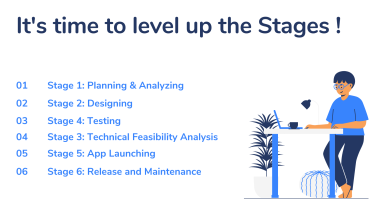Top 10 Emerging Web Development Frameworks for 2022

Web development frameworks are important tools that enable developers to create awesome websites and web applications. As the internet becomes increasingly complex, it becomes more difficult to design these tools and achieve the same level of user experience.
We’re here to tell you that a lot has changed in the past few years and we’re on the brink of seeing some major shifts in web development frameworks by 2022.
To give you an idea of what the future holds, we’ve listed our top 10 web development frameworks based on factors such as community engagement, unique features, and ease of use. Keep reading to learn more!
Top 10 Web Development Frameworks We Expect to See in 2022
1) ReactJS
Facebook-owned React is a view library that has become increasingly popular among developers. Used heavily by many top tech companies, including Facebook, Instagram, and Netflix, it’s one of the best web development frameworks out there because of its flexibility and performance.
No surprise that it’ll continue to grow in popularity among web developers in the coming years. It’s written in JavaScript and you can use it for both frontend (client) and backend (server) programming.
It also makes it easy to design interfaces that can adapt dynamically based on what users are doing or how large their screens are—this functionality makes it particularly useful for mobile app developers.
2) AngularJS
AngularJS has dominated web development frameworks in recent years. The open-source framework is quite popular with more than a million developers using it around the world, and tech giant Google uses it to power its own search engine.
AngularJS makes it easy to build single-page applications (SPAs) that are fast and responsive—and it can even run in non-HTML5 browsers like Internet Explorer 9 and 10.
With continued support from Google and enthusiastic backing from web devs everywhere, AngularJS will likely continue to reign as king of web development frameworks in 2022.
3) Flutter
Google’s mobile UI framework is a cross-platform way to develop native apps. While it won’t be replacing Android and iOS any time soon, Flutter is a great option for those developers who want to create cross-platform apps.
Since it runs on Dart, an open-source programming language created by Google in 2011, you might even consider using Flutter as your web development framework of choice as well. It’s quite similar to React Native, which we’ll talk about next.
With its Material Design interface and native performance as advantages over other cross-platform technologies, Flutter is your best bet for web development projects.
4) ASP.NET
.NET is an object-oriented framework, used to create web and desktop applications. In addition to websites, developers worldwide use it for mobile apps, due to its cross-platform capabilities.
Created by Microsoft, one can find it in various computer languages including C#, F#, and Visual Basic. ASP is short for Active Server Pages.
One of ASP’s most notable features is that it allows dynamic content on a website without having to reload pages from scratch. The best part? You can easily hire an ASP.NET web development company in India at an affordable price.
5) Ionic Framework
The Ionic Framework has grown in popularity among web developers, who use it to create cross-platform mobile apps and hybrid desktop apps using web technologies like HTML5, CSS3, and JavaScript. Microsoft’s Xamarin also falls into this category of frameworks that let you create native mobile applications using C#.
While Xamarin was recently acquired by Microsoft, there are no plans yet to integrate it with Visual Studio or include a Visual Studio add-in when building these apps.
Ionic is completely open-source, which means anyone can contribute code changes or even fork their own version (like Facebook did with React Native). It doesn’t have any servers associated with its services—you just download their command-line tools and start building.
6) Vue.js
Vue.js is a relatively new, open-source JavaScript framework that was released in early 2014. Due to its speed and flexibility, Vue has quickly established itself as one of the most popular front-end development frameworks today.
To date, it’s been used on over 11 million websites (including Alibaba and Product Hunt) and can be found in use at giants like Apple, Google, IBM, etc.
In terms of ranking, Vue sits in 14th place on GitHub with an average rating of 4.9/5 stars from 11K+ users. Most importantly though, developers love using Vue because it helps them rapidly develop applications that are beautiful and easy to maintain! And let’s not forget: It’s FREE and Open Source!
7) Ember.js
Ember.js is an open-source JavaScript framework that has a strong emphasis on convention over configuration. With its strong library of reusable components, Ember is great to use if you’re building a single-page web application or a mobile app using JavaScript.
In 2018, it became part of Rails and Ruby on Rails as one of their main default options. It’s also one of only three frameworks you can use to build Alexa skills and smart home products with Amazon Web Services (AWS).
8) Backbone.js
According to a recent survey conducted by Stack Overflow, frameworks like Backbone.js have gained popularity among developers in 2012—and it’s clear why.
Backbone.js is powerful and allows developers to do just about anything they need to build a dynamic web application, but with its lightweight design, they can also focus on making their site as fast and mobile-friendly as possible.
So If you want your website or app to be responsive no matter what device people use to access it, you should seriously consider using a framework like Backbone.js.
9) Aurelia Framework
Aurelia is a JavaScript client framework created by Rob Eisenberg. You can use it in either TypeScript or ES6 and makes use of Object-Oriented Programming to create flexible UIs with rich interactivity, super-easy navigation, and speedy load times.
The Aurelia CLI makes it simple to create components and modules without ever touching a line of code. This frees you up to focus on your users instead of frameworks. You’ll also love seeing Aurelia hit 100 percent compatibility across every major browser as well as support most IoT devices.
Aurelia Framework has put community first from day one. It has made strong commitments to issues like accessibility and open source tools, making it easy for developers around the world to write better applications faster than ever before.
10) GlimmerJS
GlimmerJS is an open-source JavaScript framework that was built by Shopify. Developers worldwide use it to build applications and websites on both desktop and mobile devices.
One of its most attractive features is that it’s extremely fast, taking advantage of ES6 modules, offloading work to a web worker, minimizing layout calculations, and leveraging browser caching. Additionally, it’s easy to learn due to its simple syntax and a high degree of reusability.
Another great feature is how easy it is to incorporate customer feedback into your site development; just one example is how quickly you can incorporate customer feedback from A/B testing into your website or application.
Read Also: The Website Development Process- Complete Guide in 7 Easy Steps!
Java Web Development Technologies You Must Know in 2022
Conclusion
So, these were our picks for the top 10 web development frameworks that you should consider for your upcoming website development project. Of course, any top-10 list is subjective and a bit arbitrary but it can be fun to speculate about what technologies will come to dominate our field over time.
What are some other frameworks that you think will come to prominence in 5 years? How do you see new platforms and trends like HTML5, mobile web development, and responsive design impacting web development frameworks? Share your thoughts in the comments section!




